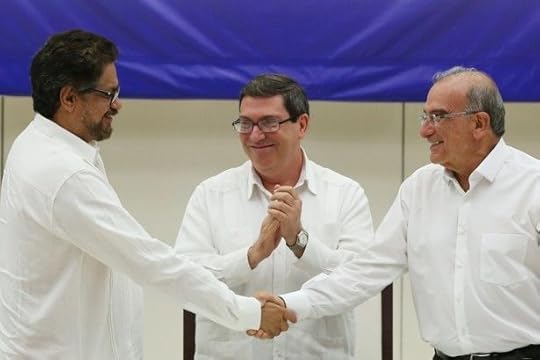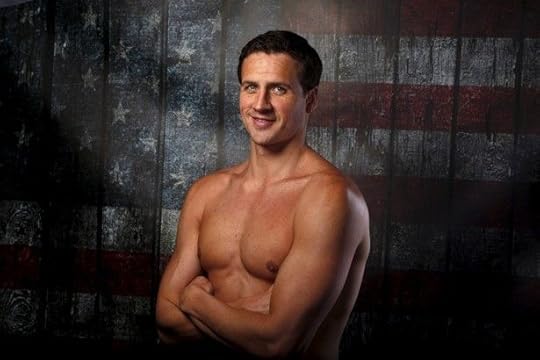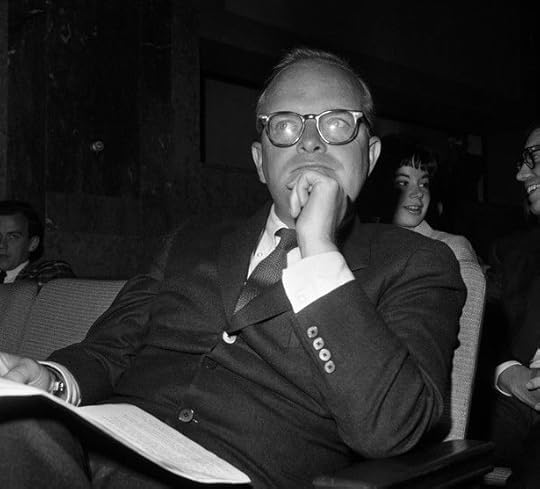Atlantic Monthly Contributors's Blog, page 92
August 25, 2016
Trump on Immigration: Schrodinger's Candidate

Maybe Donald Trump has changed his position on immigration, and maybe he hasn’t. But it’s hard to get any sort of clarity from the candidate or his campaign on what policy he really supports.
Related Story

Is Donald Trump Reversing His Stance on Immigration?
As my colleague Priscilla Alvarez reported on Wednesday, the Republican nominee has made several comments in recent days that suggested he might be softening up his views, veering away from the hardline stance in which the only suitable solution to illegal immigration was a massive deportation of some 12 million people. Trump only deepened the mystery later that day. As Benjy Sarlin wrote of a town-hall meeting taped Tuesday in Austin, Texas, “He sounded unsure of his own immigration position on Tuesday, at one point turning to the audience to survey them on the issue.”
“There certainly could be a softening,” Trump said Tuesday. “What people don’t realize—we have very, very strong laws, but they don’t follow ’em.” In practice, Trump seemed to be floating the idea of amnesty for illegal immigrants in the country, even while insisting that he did not mean amnesty:
No citizenship. Let me go a step further—they’ll pay back-taxes, they have to pay taxes, there's no amnesty, as such, there's no amnesty, but we work with them. When I look at the rooms and I have this all over, now everybody agrees we get the bad ones out, but when I go through and I meet thousands and thousands of people on this subject, and I’ve had very strong people come up to me, really great, great people come up to me, and they've said, “Mr. Trump, I love you, but to take a person that has been here for 15 or 20 years and throw them and the family out, it's so tough, Mr. Trump.”
The idea that immigrants who have been in the United States for a long time and have family in the country ought to have some way to stay sounds a lot like Republican plans for immigration reform after the 2012 election, which called for giving some people “legal status” that fell short of citizenship. Proposing amnesty, while denying it's amnesty, is a time-honored bipartisan tradition. Trump won the GOP primary in large part by bashing his opponents as being too soft on immigration. (Oliver Darcy rounds up a few tweets where Trump assailed more or less the policy he seems to be discussing here.)
But maybe Trump isn’t sure. Several times during a portion of the town hall that aired Wednesday, Trump turned to the audience and asked for their position.
“Look, this is like a poll, there's thousands of people in this room. Who wants those people thrown out?" he asked one point, then asked, “Who does not want them thrown out?” Many members of the audience cheered the idea of “working with” those in the country illegally. If Trump was seeking validation for a pivot, he may have found it.
It’s effectively impossible to tell what Trump’s position is at the moment. And his aides are no more helpful. Take this mind-bending, post-modern explanation from Trump spokeswoman Katrina Pierson on television Thursday: “He hasn’t changed his position on immigration. He’s changed the words that he is saying.”
The mysterious distinction she draws aside, that isn’t true. For example, on Christmas Eve, Trump was tweeting about the need for massive deportation raids:
Wow, because of the pressure put on by me, ICE TO LAUNCH LARGE SCALE DEPORTATION RAIDS. It's about time!
— Donald J. Trump (@realDonaldTrump) December 24, 2015
He specifically praised Dwight Eisenhower’s “Operation Wetback” in January. On Monday, he demurred, telling Bill O’Reilly “I don't agree with that. I'm not talking about detention centers.”
Trump’s equivocation has already earned him a reprimand from Ann Coulter, who—while promoting a book called In Trump We Trust—took time to accuse Trump of backing amnesty. Establishment conservatives who accused Trump of being either disingenuous on immigration or simply not understanding the situation are feeling vindicated.
Whether Trump’s vacillation will hurt him electorally is unclear. He has muddied the waters on plenty of other issues, and it’s not as though hardline immigration supporters have anywhere else to go in this election; the most likely scenario is that they’d stay home. But as the cheering crowds in Austin showed, there are many Trump supporters who want a stronger posture on border security, but aren’t actually all that insistent on deportations.
Trump, for his part, insists he has not flip-flopped, and at this point, there’s no way to know. By couching his hesitations as questions, he leaves himself room to swing back toward the hardline, or else to continue executing a slow-speed evolution toward some sort of legal status. For the time being, Trump is Schrodinger’s candidate, both the hardest-line Republican nominee on immigration in history and simultaneously a compassionate advocate for amnesty.

RuPaul's Drag Race Claims Its Queer Cultural Crown

Early in the premiere of RuPaul’s Drag Race: All Stars 2, one of the contestants disses Violet Chachki, the super-slender fashion artist crowned America’s Next Drag Superstar in the seventh season of the show. “Apparently all it takes to win is a corset, so I bought one,” says Ginger Minj, a runner-up of Chachki’s.
The other drag queens around her make mock-scandalized noises. “We’ll edit that out,” Minj says, referring to her previous comment.
“Will they though?” another contestant says.
“No they will not,” Minj replies.
And lo, they—the producers—have not.
As a satire on the ridiculousness of reality-competition TV shows rendered with queer camp verve by its cast of real-life female impersonators, RuPaul’s Drag Race already has claim to be one of the most self-aware television programs of all time. In seven years of airing on Logo TV, every sickening look and shady punchline has carried a web of references to things outside the show—with the ways that actual women look and behave being only one of many inspirations for the madness.
Now, Drag Race enters an All Stars run, assembling notable also-rans from previous seasons. The show had put on an All Stars once before, but it was in 2012—right as Drag Race was breaking through to be the No.1 conversation piece of contemporary popular gay (or at least gay male) culture. The queens returning for tonight’s All Stars premiere represent the best of Drag Race’s ongoing golden age, and the resulting ultra-meta and ultra-amusing celebration of freakiness and friendship feel like a coronation for the show.
Minj is not the only contestant to break the fourth wall, thus doing what all great queer performances do: ask the viewer to interpret on multiple levels. Roxxxy Andrews, a relentless bully during the fifth season, says “a lot of girls want to blame editing” for them looking like a villain on Drag Race but “I’m not that girl. I said those things, I played those mind games.” And when another contestant introducers herself by saying, “My name is Adore Delano, and I’m a messy slut,” you hear the producer sass back to her, “Ok, now one that Logo will sign off on?” It’s a hilarious moment because, obviously, Logo did sign off on this one—by this point, every viewer can be in on the joke. (You can see all of this in the first 12 minutes of the show, already available online.)
In an era where reality TV competitions may be getting catty, Drag Race has represented a fascinating middle: Insult comedy and performative arrogance are central to drag, a fact that encourages memorable verbal combat but also lessens the potential for real ugliness. RuPaul fashions herself as a stern but loving matriarch, drawing on the cast’s shared gay identity as motivation both to compete using versions of their best selves but also make peace at the end of the day as “sisters.”
Coco Montrese, notorious for wearing orange makeup, shows up with a clutch patterned like a Dorito.
All Stars amps up this dynamic in every way, serving up both more warmth and more play-fighting than ever. When one-time archenemies Alyssa Edwards and Coco Montrese meet, they re-enact one of their old throw-downs and Edwards—famous for delicious malapropisms—tells the camera they’ve “buried the hatch.” Even better: Montrese, once notorious for wearing overly orange makeup, shows up with a clutch patterned like the Dorito she’d previously been compared to. Throughout the 90-minute premiere, you feel the influence of the industry and culture that Drag Race has helped grow, with references to contestants’ extra-curricular activities—albums, Instagram stunts—and the fact that they’ve all spent months on the road together performing at clubs.
But despite the family-reunion vibe and all the talk of moral “RuDemption,” real conflict must eventually erupt in this battle for $100,000. The producers help that conflict along with a few successful format changes. The first task of the night is a shade-throwing challenge that traditionally comes only toward the end of Drag Race seasons. Here, it works to remind viewers of how well the queens already know each other as well as reintroduce each of their personalities. The intelligently gonzo Katya Zamolodchikova sends the room falling to the floor with a joke about one contestant’s tragic backstory; Edwards, beloved not for what she says but how she says it, blurts one-word labels that wouldn’t be funny from anyone else (“BEAST!”); Andrews demonstrates that she hasn’t lost the villain gene by once again missing the point and straight-up insulting her competition.
The most drastic change, both formally and emotionally, comes from a rules tweak. In the past, RuPaul had the bottom two competitors each week “lip sync for your life,” with the loser then going home. For All Stars, the top two queens shall “lip sync for your legacy,” with the winner scoring $10,000—and the power to eliminate one rival. Suddenly, a Survivor-esque dynamic enters with talk of “strategy” and “alliances,” inverting the show’s traditional structure where the climax of the episode is the judge’s discussion as the contestants banter backstage (the show very funnily acknowledges the switch with shots of RuPaul sipping cocktails and screaming in laughter while the queens tensely talk things over).
The final quarter of the premiere episode, and probably of future All Stars episodes, is legitimately tense viewing. The contestants seem mortified over having to cut one of their own; the queens up for elimination have panic in their eyes as they negotiate with their potential executioners. “We’re eliminating our sisters,” one of the queens cries, and the context of all the silliness that’s come before, viewers will understand why she says it with dead-seriousness.

The Orlando Shooting: Free Medical Care for the Survivors

NEWS BRIEF The two Orlando hospitals that treated the victims of the Pulse nightclub shooting will not bill any of the survivors, the hospitals announced Wednesday.
Orlando Health treated 44 of the victims, and Florida Hospital treated 12. Their combined total cost of care came to about $5.5 million, and while insurance companies will cover their usual costs—for those who had insurance—the survivors and the families of those who died while being treated at the hospitals will not pay anything out of pocket.
One victim, Mario Lopez, told the Orlando Sentinel how relieved he was to hear the news:
"I just went out for a fun night with friends. No one expected this to happen. My life was turned upside down, and then I had to worry about how I was going to pay back the hospital."
Lopez, who is uninsured, was grazed by a bullet and had fragments explode into his left side. After he was hit, he fell and split his elbow on a shard of glass. His seven-hour hospital visit left him with a new nightmare: a potential $20,000-bill.
The June shooting at the Pulse nightclub was the most deadly in modern U.S. history. A gunman rushed in and killed 49 people. It was later learned he had pledged loyalty to the Islamic State, though there’s no evidence directly linking him to the terrorist group. The nightclub is a few blocks away from Orlando Health’s trauma center, and nine victims died shortly after arriving there.
In a statement to the Sentinel, the hospital’s CEO, David Strong, said that “during this very trying time, many organizations, individuals and charities have reached out to Orlando Health to show their support. This is simply our way of paying that kindness forward.”
The hospital said it will also cover any future costs for the victims’ surgeries or care.

August 24, 2016
A Peace Deal For Colombia

NEWS BRIEF The Colombian government and FARC have finalized a peace agreement, tentatively drawing to a close five decades of conflict with the largest guerrilla movement in the Western Hemisphere.
Negotiators announced the deal Wednesday in Havana, Cuba, where talks between the government and FARC first began in 2012.
FARC, also known as the Revolutionary Armed Forces of Colombia, first launched its left-wing insurgency in 1964, plunging the county in a bitter conflict that cost over 200,000 lives. Both sides had agreed to a preliminary ceasefire in June.
The New York Times has more details on the deal:
It outlines a timetable in which the rebels […] will abandon their arms. It also sets out a pathway in which former fighters will enter civilian life again — and in some cases, run for office.
But to most Colombians, the deal is simply a promise that the war, which has lasted 52 years, claimed some 220,000 lives and displaced more than 5 million people, is at last coming to an end.
Peace in Colombia now looks more likely than ever, but a big hurdle still needs to be cleared before the deal is ratified. President Juan Manuel Santos, who has staked his legacy on peace, must now sell the agreement to his people, who will be asked to vote in an up-or-down referendum on the deal.
Foreign leaders from across the ideological spectrum reacted warmly to the announcement. UN Secretary-General Ban Ki-Moon praised both sides for their “hard work and patience,” while the White House called it a “historic day” and a “critical juncture” on the path to peace.
In neighboring Venezuela, where the government has previously acted as a mediator between the rebels and Colombian leaders, President Nicholas Maduro welcomed the agreement.
Reitero mis felicitaciones a Colombia por acuerdos definitivos firmados hoy en La Habana,cuenten con todo el apoyo para construir La Paz...
— Nicolás Maduro (@NicolasMaduro) August 25, 2016
The referendum is scheduled for October 2, according to the BBC. Opposing Santos and the peace deal is former president Alvaro Uribe, who led an aggressive military campaign against FARC and other guerrilla groups during his administration. Uribe has harshly criticized the agreement for what he sees as its excessive leniency toward FARC and its leadership.

Can Ryan Lochte Redeem Himself on Dancing With the Stars?

When Paula Deen introduced herself as one of the eponymous celestial bodies on the 21st season of Dancing With the Stars, she did so with the understated enthusiasm you might expect from a Food Network host. “Hello, my name is Paula Deen,” she told the ABC show’s live audience, grinning, “and I’m probably most known for cookin’.”
This was, of course, false. Deen was at the time most known for a series of racist comments and actions that, when revealed in 2013, horrified many of the people who had looked up to her (or at least who had looked to her for advice on the perfect way to make a flaky buttermilk biscuit). Deen had come to the Dancing With the Stars stage to do what so many others in her situation had done before: to rehab her reputation, one bedazzled cha-cha at a time.
Rumor has it that, now, another celebrity will soon be joining the show’s redemption-seeking ranks: Ryan Lochte, who in the wake of Drunkenlyvandalizingagasstationbathroomandthensayinghewasrobbedatgunpoint-gate finds himself in need of some good PR. (Going on the Today show not to admit that he lied but rather to declare that he “over-exaggerated” his story turns out, unsurprisingly, not to have cut it.) The reports of his appearance are unsubstantiated at this point—“the cast of celebrities for the upcoming season of the ABC dancing competition has not yet been announced and reps for the show never comment on casting rumors,” US Weekly notes—but “an insider” tells the magazine that “doing DWTS will be great for Ryan’s image!”
Lochte may be looking to do what so many others have done before: rehab his reputation, one cha-cha at a time.
The insider adds: “He will be able to show America that he’s a good guy who made a mistake.”
The proving of one’s moral goodness is a lot of ask of the show that found Deen, during her own Redemption Tour, costumed at one point as Marie Antoinette—bleached-blonde bouffant and all—but it is also a recognized ritual. The former House majority leader Tom DeLay went on the show after a jury convicted him, in 2010, of money laundering. Bristol Palin went on to clear the air after the various scandals of the 2008 presidential campaign. Jodie Sweetin went on after her well-publicized struggles with substance abuse. Jerry Springer went on after the world wearied of the chair-throwing melodramas of his talk show. Gary Busey went on after being Gary Busey.
Related Story

The Enduring, Shiny Appeal of Dancing With the Stars
There is something very pure, and also vaguely puritanical, about the redemption narrative the show sells: Humiliate yourself, ideally clad in a combination of spandex and sequins, and ye shall find forgiveness. It’s a ritual, purveyed by the show’s producers, that at this point carries an established catechism. As DWTS’s casting director, Deanna Katz, told Slate of the standard pattern: “Week 1, you acknowledge that this thing is what you’re known for. You say it, you come clean, and then it’s over. The elephant in the room is gone. Then you can control the narrative.”
So Bristol Palin, for example, began the show’s Season 11 premiere clad in a politician-proper suit, with her dark hair in an updo—looking, in other words, exactly like her (in)famous mother. But then: Palin dramatically ripped off that costume to reveal the real outfit she’d be rocking for the evening: a red minidress, decked out with fringe. There was nothing subtle about the optics of this (subtlety, in general, is not one of the selling points of a show whose prize is a plasticine “mirror ball trophy”). Instead, it was an in-your-face conversion: The ceremonial shedding of baggage, right there on the stage! Caterpillar to butterfly, by way of the ballroom! “My life’s been told and spread out in tabloids, but I’m just a regular girl,” Palin told the audience, both live and at home, thus completing the story.
The amazing thing is: The transformation is often quite effective. The appeal of DWTS as both a show and an ethic is that it celebrates values that mesh well with many Americans’ own conceptions of themselves: It rewards humility, and bravery, and partnership, and, above all, good, hard work. It revels in the failures on display in couples’ rehearsals—cha-chas not fully cha’ed, foxtrots not fully foxed—and offers, each week, a mini-redemption narrative as the celebrity in question painstakingly learns a new dance. There have been, in the course of all this, many injuries on the show. Marie Osmond, after a particularly exerting dance during the show’s live broadcast, fainted as she awaited her scores. Jodie Sweetin injured her ankle during rehearsals with her partner, Keo Motsepe. Tom DeLay sustained a pre-stress fracture in his foot during his rehearsal with Cheryl Burke.
But then: “No worries,” the man formerly known as “The Hammer” tweeted of the injury, “it’ll take more than that to keep me off the dance floor.”
The show doesn’t erase the past; it does, though, try its best to change the subject.
And: It did! (Specifically, it took “Latin Night,” low scores from the judges, low enthusiasm from the American public, and a double elimination to end DeLay’s dancing career.) Still, with his appearance on the show—and with his exhibited willingness to go on live air, injury and all, clad in barbershop-style red-and-white stripes and dancing the samba to “Why Can’t We Be Friends?”—DeLay became not just “the disgraced politician,” but also “the guy who gamely made a fool of himself on national TV.” The punchline became just a little more human.
And if Lochte is, indeed, following in DeLay’s footsteps, the swimmer might find similar benefits through his appearance on the show. (Can’t you just see Lochte doing a rhumba to a remix of Frank Ocean’s “Swim Good”? Isn’t it, in its awkward way, just a little bit charming?)
Dancing With the Stars may not bring full redemption for those who seek it at the show’s spangly, sequiny altar. What it does offer, though, are the distractions that can come with bright, shiny things. The show doesn’t erase the past; it does, though, try its best to change the subject. When Deen was eliminated in the sixth week of the show, US Weekly nabbed an “exclusive” interview with her. Deen talked, during the conversation, about the “racy routine” she performed with the professional dancer Mark Ballas. She talked about losing 35 pounds before, and during, the show’s airing. She did not talk about the scandals that had sent her on the show in the first place; she didn’t need to. Those, apparently, had been washed away in the sheen of sequin and sweat and samba. Instead, Deen said, she wanted her story to serve as “an inspiration” to others. “I hope everybody saw me over these six weeks, and I hope it gives them hope and encouragement,” Deen said. “I hope all the women out there got the message that I was trying to send to them. Get up and do it!”

Italy Earthquake: What We Know

What we know:
—A magnitude-6 earthquake in central Italy has killed at least 159 people Wednesday. Scores more are missing.
—The worst-affected areas are the villages of Arquata and Pescara del Tronto in the Marche region, and Accumoli and Amatrice, which are in Lazio.
—We’re live-blogging the major updates. All updates are in Eastern Daylight Time (GMT -4).
5:59 p.m.
Italy's Civil Protection Department says at least 159 people have now died in the earthquake, the AP reports.
4:24 p.m.
President Obama spoke with his Italian counterpart, Sergio Mattarella, to offer his condolences and assistance on Wednesday, the White House said in a statement.
The President spoke by phone today with President Sergio Mattarella of Italy to offer his deepest condolences on behalf of the American people to the people of Italy following the devastating earthquake that struck central Italy overnight. President Obama saluted the quick action of first responders and volunteers who have been working to save lives. Reaffirming the strong bonds of friendship between the United States and Italy, the President underscored that the United States stands ready to provide any assistance needed during this difficult time.
2:55 p.m.
In an article on Italy's notoriously lax building standards, the Guardian’s John Hooper notes the earthquake’s timing could keep its death toll lower compared to a similar temblor that struck the peninsula in 2009.
The casualty tally will nevertheless be far higher than it should be in a country of Italy’s wealth – but much lower than it might have been. The 6.2-magnitude earthquake, like the one that devastated L’Aquila, struck at night.
Had people been at work, in shops or at school, the outcome would have been much worse. Two years ago, Gian Vito Graziano, president of Italy’s National Council of Geologists, said that according to some estimates, if the L’Aquila earthquake had struck when students were in their classrooms, “the number of victims would have been thousands, not hundreds.”
1:45 p.m.
Some of the images coming out of Italy show the extent of damage. Amatrice especially seems to have been flattened.

(Gregorio Borgia / AP)
1:29 p.m.
Matteo Renzi, the Italian prime minister, has raised the death toll to 120. He said more than 300 others are missing.
#Terremoto Renzi: al momento almeno 120 morti, 368 feriti. Emergenza avrà lunga gestione, garantiremo ricostruzione https://t.co/GdRnpgxfSy
— Agenzia ANSA (@Agenzia_Ansa) August 24, 2016
Rescuers are looking for survivors in the areas affected.
10:21 a.m.
ANSA has more on the breakdown of the toll:
Of the victims, 35 were counted in the Lazio village of Amatrice, 11 in the nearby village of Accumoli, and 17 confirmed in a hospital morgue in the city of Ascoli Piceno. These include fatalities from the villages of Arquata and Pescara del Tronto, plus a little girl from Amatrice who was extracted from the rubble alive but died in hospital.
10:03 a.m.
Italy’s Civil Protection Department, which is dispatched during crises like this one, says the death toll stands at 73.
+ NEWS/ Protezione Civile, #terremoto: 73 morti nuovo bilancio. +
— Rai Radio1 (@Radio1Rai) August 24, 2016
10:01 a.m.
Italian state police have released aerial footage of the affected area.
#terremoto le immagini dei paesi colpiti dal sisma dagli elicotteri della #poliziadistato pic.twitter.com/UIn5HawgO1
— Polizia di Stato (@poliziadistato) August 24, 2016
9:10 a.m.
ANSA, the Italian news agency, is reporting that the death toll has risen to 63. The number isn’t official, but is based on the news agency’s reporting from the area devastated by the quake, as well as from counts from local officials. Here’s more:
Of these, 35 were counted in the Lazio village of Amatrice, 11 in the nearby village of Accumoli, and 17 confirmed in a hospital morgue in the city of Ascoli Piceno. These include fatalities from the villages of Arquata and Pescara del Tronto, plus a little girl from Amatrice who was extracted from the rubble alive but died in hospital.
8:34 a.m.
The death toll is likely to rise. Rai, the Italian broadcaster, says the death toll in Amatrice alone is 35.
#terremoto +++ 35 vittime accertate solo ad #Amatrice +++ pic.twitter.com/QfF63xKqsw
— Rainews (@RaiNews) August 24, 2016
7:57 a.m.
We’re getting images now of the damage in Pescara del Tronto, which is located on a hillside. It looks as if much of the village has been reduced to rubble.
#Terremoto Pescara del Tronto. Il paese è raso al suolo. Macerie e soccorsi. Video @NicoleRamadori pic.twitter.com/TTFeslcZ1H
— Rai Radio1 (@Radio1Rai) August 24, 2016
Prime Minister Matteo Renzi told the nation he will visit the area Wednesday afternoon.
7:33 a.m.
The U.S. Geological Survey, which tracks quakes around the world, says the quake had a magnitude of 6.2. Here’s the region where it struck:
M6.2 #earthquake 10km SE of Norcia, Italy https://t.co/HlZXIejr4U pic.twitter.com/RFGhTvKICk
— USGS (@USGS) August 24, 2016
7:17 a.m.
Italian authorities say a magnitude-6 earthquake in the central part of the country has killed at least 38 people. Dozens more are missing in the quake that struck in the early hour of Wednesday morning.
The death toll so far is confined to four villages: Arquata and Pescara del Tronto (10 dead), which are in Marche, and Accumoli and Amatrice (28 dead), which are in Lazio.
Here’s more on the quake from ANSA, the Italian news agency:
The earthquake, which struck at 03:36 local time and was followed by a second, 5.4 magnitude seism at 04:33 between Umbria and the Marche, was said by civil protection authorities to be "comparable in intensity" to the 2009 L'Aquila earthquake in which over 300 people died.
There were reports of "apocalyptic scenes" with many collapsed buildings in the towns and villages affected. Rescuers had difficulty accessing the area due to landslides and damaged infrastructure.
This is a developing story and we’ll update it as we learn more.

Who Wants to Buy Truman Capote's Ashes?

Truman Capote knew from a young age, he once told The New York Times, that “I was a very special person, and I had to have a very special life.”
The author of Breakfast at Tiffany’s and In Cold Blood did indeed lead a special life, both as one of the most famous postwar American authors, and as a New York socialite and friend of the famous. Near the end of his life, Capote moved from New York to live in Los Angeles with the late Joanne Carson. After Capote died on August 25, 1984, some of his ashes stayed with Carson, in a carved wooden box, in a room she kept as intact as a shrine.
Capote’s ashes have been stolen and salvaged twice. After her death last year, her estate put the remains up for auction. The bidding is scheduled to open September 23, and starts at $2,000. The Los Angeles auction house in charge, Julien’s Auctions, has valued the ashes to be between $4,000 and $6,000.
Here they are:
You can buy Truman Capote's ashes now https://t.co/JIl8XtADia pic.twitter.com/UdAxQYtpPc
— Natasha VC (@natashavc) August 24, 2016
Also for sale are a bunch of Capote’s trousers and collared shirts, as well as the polo and swimsuit Capote was wearing when he died. In death, Carson often said she found comfort in speaking to Capote’s ashes. One night in 1988, after her 57th birthday party, Carson walked into Capote’s old room to bring him balloons and noticed the ashes were missing. Carson later told People magazine she “felt cold water running through” her heart when the realization sunk in. But six days later, the ashes mysteriously returned. Carson said she heard a car speed away from her home, and when she went outside to investigate she found Capote’s remains coiled up in a garden hose.
The ashes were later stolen again, but little is known about the incident. After that, Carson kept Capote’s ashes at a Los Angeles cemetery, near the remains of Marilyn Monroe, one of Capote’s favorite Hollywood stars.
Darren Julien, the CEO of Julien’s Auctions, the auctioneer handling Capote’s remains, told Vanity Fair last week that while it’s unusual, the sale of human parts is not unprecedented. Most notably, Napoleon’s penis—or what is believed to be his penis—was auctioned in 1977 and now resides in a private New Jersey home. Actor William Shatner sold his kidney stone in 2006.
Julien said he understands how some people may see the auction as disrespectful. But Capote wouldn’t think so, he said. “Truman Capote loved the element of shock,” Julien told Vanity Fair. “He loved publicity. And I’m sure he’s looking down laughing, and saying, ‘That’s something I would have done.’”

A Short History of Candidates Relying on 'Hidden' Voters

A candidate or operative on a campaign that's losing has three options: despair; accept what’s happening and try to fix it; or deny. Right now, the Donald Trump campaign is exhibiting all three.
For despair, there are the staffers who are reportedly “suicidal” inside Trump Tower, and those who have simply quit. For acceptance, Trump himself has admitted he’s in trouble. But newly promoted campaign manager Kellyanne Conway is taking the denial route.
“Donald Trump performs consistently better in online polling where a human being is not talking to another human being about what he or she may do in the election,” she told the British outlet Channel 4. “It’s because it’s become socially desirable, if you’re a college educated person in the United States of America, to say that you’re against Donald Trump.”
Pressed to say how many voters might be included, Conway declined to elaborate but added, “I call it the undercover Trump voter, but it’s real.”
The idea is not new, and it’s commonly voiced by voters at Trump rallies these days. At the Republican National Convention, New York delegate Bob Hayssen told me, “There are millions of people out there that are afraid to admit they’re going to vote for Donald Trump.” Why not? “They’re going to get bashed by their liberal friends!”
Few phrases in politics are so mocked as the old standby, “The only poll that matters is on election day.” But when a trailing politician mouths that banal truth, she is at least acknowledging that the polling looks bad. The hope that some crop of hidden or undercover voters is waiting to save the candidate may be more deserving of mockery.
It is a wish with a long pedigree. The most famous example is the one where it really was true: Harry S Truman’s surprise victory of Thomas Dewey in 1948, memorialized with that headline. Gallup’s polling had shown Dewey leading by at least 5 points and sometimes as much as 11 since the start of August. The polling was wrong, and the president was reelected. Ever since, politicians who are in a hole have hoped the polls are simply bad. But Truman’s victory forced pollsters to reassess their methods, ironing out some of the problems that led to a misreading of the 1948 election, making it less likely that history would repeat itself.
In 1969, Richard Nixon warned that there was a “Silent Majority” that was opposed to the bra burners, anti-war protestors, and rioters in the streets. Trump has appropriated the phrase, repeatedly claiming that there’s a silent majority that supports him, too. But Nixon’s phrase wasn’t really a reference to elections—it was just about public discourse that he felt was dominated by a few noisy voices. And while they may have been silent, they weren’t invisible: Polls showed Nixon trouncing George McGovern ahead of the 1972 election, as he did. That didn’t stop McGovern from claiming hidden groups of voters would propel him to an upset victory. “We may see a thorough discrediting of the public-opinion polls in this campaign just as Harry Truman discredited them in 1948,” he said on the eve of an election in which he won just 17 electoral votes.
Via Nate Silver, here’s Democrat Walter Mondale in 1984, just a week before he lost by more than 18 points to President Ronald Reagan:
There's something going on in this country and the pollsters aren't getting it. Nobody who's been with me for the last few days and has seen these crowds, seen their response, seen their enthusiasm, seen the intensity of their response and how they respond to these issues, no one who's been where I've been, can help but believe that there's something happening in this country.
His speechwriter told The New York Times, “There's not a whiff of defeat because there's a conviction that something is happening that the polls aren't registering.”
Four years later, Democrat Michael Dukakis apparently hadn’t learned the lesson that crowd size means nothing. “I smell victory in the air, don't you?” he said in Kentucky. His wife and campaign manager forecast an upset. Robin Toner reported:
The crowds have been growing steadily—there were 10,000 in Sioux Falls, S.D., last week—and ever more spirited. They roar their encouragement, as if to deny the national polls showing their candidate trailing. It is hard to smell defeat amid the chanting and the cheers.
Dukakis lost by nearly eight points to George H.W. Bush.
Even Bob Dole, whose campaign against Bill Clinton was ailing so badly in 1996 that the Republican Party had diverted its resources to other races, indulged in the fantasy, as Adam Nagourney reported:
In the final hours of Bob Dole's campaign, the candidate took to appearing with a reproduction of a famous newspaper headline, which gave Mr. Dole hope in the face of discouraging polls. ''Dewey Defeats Truman,'' The Chicago Daily Tribune declared in 1948, the evening before Harry S. Truman won re-election to the Presidency.
At one rally, Dole joked, “I’m like Harry Truman. I’m from the Midwest, and I’m plainspoken, and I’m going to win whether you like it or not!” He didn’t.
Heading into the home stretch of the 2008 campaign, John McCain’s pollster released a memo making the case that “all signs say we are headed to an election that may easily be too close to call by next Tuesday.” The Wall Street Journal reported on where Bill McInturff believed the extra McCain votes were just waiting to come out of the woodwork:
“The strongest sub-groups for McCain are non-college men and rural voters of both genders,” McInturff said. The campaign has also seen more reason to hope that they will get more than a “20% chunk” of soft Democrats. “Wal-Mart women,” which the campaign describes non-college-educated women in households making less than $60,000 a year, are “swinging back solidly,” McInturff said.
Essential to this argument was a belief in the Bradley Effect, the idea that polling underestimates support for white candidates in elections with one white and one black candidate. (It’s named for Tom Bradley, an African American Los Angeles mayor who lost the 1982 California governor’s race to a white candidate despite leading in polls.) Mark Blumenthal wrote at the time that there was little evidence that there were a “hidden McCain vote,” and the election results bore him out.
Four years later, against a now-incumbent Barack Obama, Mitt Romney committed the same error. On Election Day, Romney arrived at the Pittsburgh airport, where he was met by a huge, cheering crowd. That’s what convinced him he’d win. He told reporters:
Intellectually I’ve felt that we’re going to win this, and I’ve felt that for some time. But emotionally, just getting off the plane and seeing those people standing there—we didn’t tell them we were coming. We didn’t notify them when we’d arrive. Just seeing people there, cheering as they were, connected emotionally with me.
Romney felt so good he didn’t even write a concession speech until that evening, when the writing was on the wall. Just as for McGovern, Mondale, and Dukakis, the crowd was a mirage, and Romney lost. A campaign adviser told CBS that running mate Paul Ryan was “genuinely shocked.” In his case, it turned out there had been a hidden vote—but it was for Obama. The Romney campaign underestimated the number of minority voters who would turn out.
That brings us to 2016, and Conway’s belief in the hidden voter. That belief has proven to have a pretty bad track record in the past. But could it be vindicated this November?
Conway’s case depends on “social desirability bias,” the idea that Trump voters are reluctant to admit that they support their candidate because they might be judged by friends, family, and neighbors for it. From a certain point of view, the idea that even his own supporters deny him might look like further evidence that Trump is in trouble, though to its proponents, this is just evidence of how effectively the noisy majority bullies the silent majority, forcing them to succumb to the mores of political correctness that Trump and his supporters so despise.
Earlier in the campaign, it was true that Trump’s support was higher in scientific online surveys (i.e., not those polls on random news websites) than in telephone surveys. But as Nate Cohn wrote, the live phone surveys were also more accurate reflections of Trump’s support.
Meanwhile, a host of smart poll analysts have explained in detail why it doesn’t look like there’s a chunk of voters who are missing or simply lying about who they support. Trump may have a path to victory by winning a tremendous portion of white voters. Sean Trende was arguing long before the Trump phenomenon that there was a large cache of “missing white voters” who a Republican candidate might be able to turn out and ride to victory. But there’s no sign that Trump is building the sort of large and sophisticated voter identification and turnout operation it would require to get a large group of infrequent voters to the polls—or even to make sure regular voters show up. On the flip side, it’s not all that surprising that a candidate who has gone out of his way to offend many groups of Americans would be struggling in the polls.
As for the thousands turning out at rallies, Trump has bragged for months about his crowds. More recently, his tune has changed somewhat. “I don’t know why we’re not leading by a lot. Maybe crowds don’t make the difference,” he said in Florida in early August. That’s more than career politicos from McGovern to Dukakis to Romney were willing to admit.

Canada's Hijab-Friendly Police Uniforms

NEWS BRIEF The Royal Canadian Mounted Police (RCMP) will now allow its female officers to wear the hijab as part of its official uniform, the Associated Press reports.
Scott Bardsley, a spokesman for Public Safety Minister Ralph Goodale, said Wednesday the addition to the uniform aims to better reflect the diversity of Canada, as well as encourage more Muslim women to join the “Mounties,” as the police force is called. Of the approximately 19,000 Canadians employed by the force, 20 percent are women, though it is unclear how many of them will be affected by this new policy.
“The Royal Canadian Mounted Police is a progressive and inclusive police service that values and respects persons of all cultural and religious backgrounds," Bardsley told AP in an email.
The decision by the RCMP follows similar uniform policy changes made to Canadian police services in Toronto and Edmonton, as well as in police forces throughout the United Kingdom, Sweden, Norway, and the United States.
The RCMP has updated its uniform standards in the past to reflect the diversity of those serving within its ranks. In the late 1980s, Baltej Singh Dhillo, an RCMP recruit and a practicing Sikh, petitioned the Canadian government to allow the turban worn by Sikh men to be included in the Mountie uniform. In 1990, the government accepted the change.
Canada’s decision contrasts with the current burqini ban debate in France, where at least 15 towns have implemented bans prohibiting people from wearing full-body swimsuits favored by some Muslim women. Though some Canadian lawmakers in Quebec have called for Canada to outlaw the conservative swimwear, Prime Minister Justin Trudeau dismissed the idea Monday, calling instead for Canadians to practice tolerance toward others.
“In Canada, can we speak of acceptance, openness, friendship, understanding? It is about where we are going and what we are going through every day in our diverse and rich communities," he said.

The Swath of Maine That Just Became a National Monument

NEWS BRIEF A chunk of Maine is the newest national monument.
President Obama on Wednesday designated 87,500 acres of forests and rivers filled with moose, bears, and rare birds as the Katahdin Woods and Waters National Monument in Maine’s North Woods. The announcement comes a day before the 100th anniversary of the National Park Service, the government agency that manages national parks and monuments.
Theresa Pierno, president and chief executive of the National Parks Conservation Association, told The Washington Post this “may be one of the last, large national parks that we see in our lifetime.”
But getting here has been a challenge for the people donating the land, Burt’s Bees co-founder Roxanne Quimby and her son Lucas St. Clair. As the Portland Press Herald reported last week:
The family had initially hoped to create a North Woods national park but switched their short-term focus to a national monument because presidents can make such designations by executive action. National parks require an act of Congress.
St. Clair has been unable to win support from all of Maine’s congressional delegation because of outspoken opposition to the national park—and to the national monument—by some Katahdin region residents and representatives of the state’s forest products industry.
They were eventually able to donate the $60 million worth of land to create the country’s 413th national park site. They also added hunting and snowmobile protections to appease local residents, making the monument the only one in the U.S. to allow hunting. Quimby has pledged $20 million toward operations and maintenance, along with an agreement to raise an additional $20 million for the new monument.
The designation comes 100 years after President Woodrow Wilson established the Sieur de Monts National Monument, which today is Acadia, Maine’s only national park. Quimby last week donated an additional 100 acres to Acadia, valued at around $2 million.

Atlantic Monthly Contributors's Blog
- Atlantic Monthly Contributors's profile
- 1 follower



